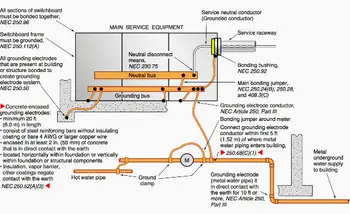Capacitive Load For Performance and Efficiency
By R.W. Hurst, Editor
Grounding and Bonding and The NEC - Section 250
Our customized live online or in‑person group training can be delivered to your staff at your location.

- Live Online
- 12 hours Instructor-led
- Group Training Available
Download Our OSHA 3875 Fact Sheet – Electrical PPE for Power Industry Workers

- Follow rules for rubber gloves, arc-rated PPE, and inspection procedures
- Learn employer obligations for testing, certification, and training
- Protect workers from arc flash and electrical shock injuries
A capacitive load causes current to lead voltage in AC circuits. To calculate power factor, divide real power (kW) by apparent power (kVA). Capacitive loads can correct lagging power factor caused by inductive loads, improving efficiency in electrical systems.
What is "capacitive load"?
A capacitive load stores energy in an electric field and causes current to lead voltage.
✅ Used to correct lagging power factor in AC circuits
✅ Common in capacitor banks and power factor correction systems
✅ Helps reduce energy losses and improve system efficiency
A capacitive load primarily comprises capacitors, which temporarily store electrical energy in the form of an electric field. These capacitors have the unique characteristic of leading the voltage in AC circuits, meaning that the current waveform peaks before the voltage waveform. This phenomenon results in a leading power factor, which can impact the overall power factor of the electrical system. Capacitive loads play a vital role in improving energy efficiency by supporting systems with a lagging power factor caused by inductive components.
One of the primary impacts is their effect on reactive power. Reactive power is the portion of electrical power oscillating between the load and the power source without being consumed or converted into useful work. It is essential in maintaining voltage levels in the power system, but can create inefficiencies if not properly managed. For a deeper understanding of how capacitive loads influence system reliability, explore our comprehensive Power Quality Overview page. To see how reactive and real power interact in AC systems, visit our comparison of real vs reactive power.
How It Works (with Key Formulas)
Capacitive loads oppose changes in voltage and shift current to lead the voltage waveform.
Sign Up for Electricity Forum’s Power Quality Newsletter
Stay informed with our FREE Power Quality Newsletter — get the latest news, breakthrough technologies, and expert insights, delivered straight to your inbox.
-
Capacitive Reactance (Xc):
Where:
f= frequency (Hz)C= capacitance (farads)
- Power Triangle Relationship:

- Where:
P= real power (kW)S= apparent power (kVA)φ= phase angle between current and voltage
In a capacitive circuit, reactive power (Qc) is negative, as capacitors supply rather than absorb VARs.
Power factor correction is a technique used to improve the efficiency of electrical systems by reducing the amount of reactive power present. Capacitive loads and inductive loads, such as electric motors, can significantly affect the power factor. By introducing capacitors in the form of capacitor banks, power factor correction can be achieved, ultimately enhancing the overall efficiency of the electrical system. You can explore the function and applications of capacitor banks, which are essential for effective power factor correction in industrial environments.
Capacitor banks are assemblies of multiple capacitors connected in parallel or series, used to manage capacitive loads effectively. They store and release energy to balance the reactive power in the system, thereby reducing power losses and stabilizing voltage levels. Capacitor banks are widely used in industrial and commercial settings to mitigate the adverse effects.
Capacitive reactance measures a capacitor's opposition to the flow of alternating current (AC) in AC circuits. It is inversely proportional to both the frequency of the AC signal and the capacitance of the capacitor. The formula for calculating capacitive reactance (Xc) is Xc = 1 / (2 * π * f * C), where f is the frequency of the AC signal and C is the capacitance of the capacitor. Understanding capacitive reactance is vital for designing and analyzing AC circuits. For a deeper explanation of how to compute energy efficiency, see our full guide on how to calculate power factor.
Load balancing distributes electrical loads evenly across a power system to ensure optimal performance and efficiency. In systems with capacitive loads, proper load balancing helps maintain voltage stability and prevents the overloading of certain components. It can be achieved through the strategic placement of capacitor banks and the use of power factor correction techniques. Learn about the distinctions between different kinds of loads, including resistive load, and how they compare to capacitive loads in power systems.
Voltage regulation is essential for maintaining stable voltage levels throughout an electrical system, and it can significantly impact this process. By influencing reactive power and power factor, capacitive loads can cause voltage fluctuations and instability if not properly managed. However, voltage regulation can be effectively maintained with the use of capacitor banks and power factor correction methods. Understand how automatic power factor controllers dynamically maintain optimal system performance in real time.
Capacitive loads have both advantages and disadvantages in electrical systems. On the one hand, they can improve power factor, reduce power losses, and provide voltage support when properly managed. However, on the other hand, they can lead to voltage fluctuations, system instability, and increased wear on electrical components if not correctly balanced.
Types of Capacitive Loads
Capacitive loads store electrical energy in a capacitor and release it back into the circuit. Unlike resistive loads or inductive loads, CLs have the characteristic of the current reaching its peak before the voltage does.
Capacitive loads are often combined with other electrical loads, especially inductive loads, to improve their efficiency and power factor. Loads include:
-
Power factor correction devices: These electronic devices correct power factor issues that can arise when using inductive loads. They are designed to add capacitive loads to an electrical system, thereby balancing the inductive loads and improving energy efficiency.
-
Electric motors: Certain electric motors, such as synchronous and capacitive motors, contain capacitive loads that regulate the motor's speed and efficiency. This includes various types of electrical load configurations.
-
Fluorescent lights: The ballast in fluorescent lights contains capacitive loads that help regulate the electrical current and voltage of the light.
-
Air conditioning units: Air conditioning units and heating elements contain them in their compressor and motor circuits that help regulate the flow of electrical energy and improve energy efficiency.
-
Electronic devices: They are commonly used in electronic devices such as computers, televisions, and audio systems to regulate the flow of electrical energy and improve the device's efficiency, as they consume electrical energy.
FREE EF Electrical Training Catalog
Download our FREE Electrical Training Catalog and explore a full range of expert-led electrical training courses.

- Live online and in-person courses available
- Real-time instruction with Q&A from industry experts
- Flexible scheduling for your convenience
If you're interested in learning how all these factors influence system voltage stability, our article on voltage dropping covers the key causes and solutions.
Related Articles








